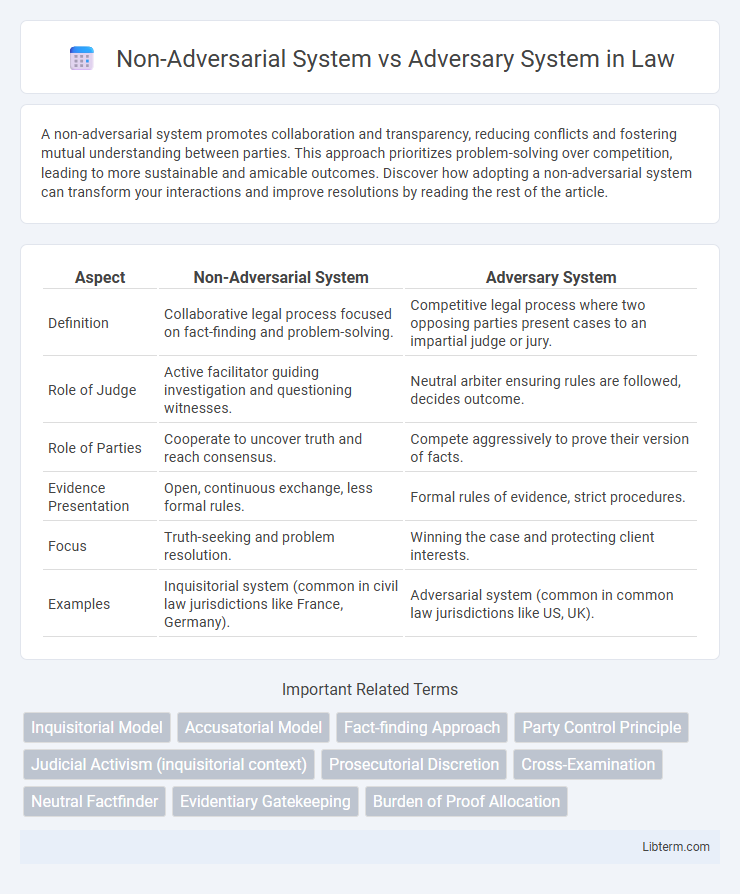A non-adversarial system promotes collaboration and transparency, reducing conflicts and fostering mutual understanding between parties. This approach prioritizes problem-solving over competition, leading to more sustainable and amicable outcomes. Discover how adopting a non-adversarial system can transform your interactions and improve resolutions by reading the rest of the article.
Table of Comparison
| Aspect | Non-Adversarial System | Adversary System |
|---|---|---|
| Definition | Collaborative legal process focused on fact-finding and problem-solving. | Competitive legal process where two opposing parties present cases to an impartial judge or jury. |
| Role of Judge | Active facilitator guiding investigation and questioning witnesses. | Neutral arbiter ensuring rules are followed, decides outcome. |
| Role of Parties | Cooperate to uncover truth and reach consensus. | Compete aggressively to prove their version of facts. |
| Evidence Presentation | Open, continuous exchange, less formal rules. | Formal rules of evidence, strict procedures. |
| Focus | Truth-seeking and problem resolution. | Winning the case and protecting client interests. |
| Examples | Inquisitorial system (common in civil law jurisdictions like France, Germany). | Adversarial system (common in common law jurisdictions like US, UK). |
Introduction to Legal Systems: Adversarial vs Non-Adversarial
The adversarial system features two opposing parties presenting evidence and arguments before an impartial judge or jury, commonly used in common law jurisdictions like the United States and the United Kingdom. The non-adversarial system, also known as the inquisitorial system, relies on a judge actively investigating the facts and questioning witnesses, prevalent in civil law countries such as France and Germany. Understanding these systems is crucial for comparative legal studies as they shape the procedures, roles of legal actors, and the overall approach to justice administration.
Core Principles of the Adversary System
The Adversary System operates on the core principles of party control, where opposing sides present evidence and arguments before an impartial judge or jury, ensuring a fair contest of opposition. It emphasizes the presumption of innocence and the burden of proof resting on the prosecution, fostering rigorous examination through cross-examination and procedural safeguards. This model prioritizes procedural fairness, transparency, and the right to legal representation to uphold justice within a structured, competitive framework.
Key Characteristics of Non-Adversarial Systems
Non-adversarial systems emphasize cooperation, transparency, and consensus-building between parties to resolve disputes, contrasting with adversarial systems that rely on opposing sides to present conflicting evidence. Key characteristics include a focus on mutual agreement, reduced conflict intensity, and procedural flexibility that fosters trust and open communication. This approach often results in faster resolutions and lower costs by minimizing confrontational tactics and promoting collaborative problem-solving.
Comparative Analysis: Decision-Making Processes
Non-adversarial systems prioritize collaborative decision-making, focusing on mutual agreement and consensus-building between parties, which often leads to more integrative solutions and reduced conflict. Adversarial systems rely on opposing parties presenting their cases to an impartial judge or jury, emphasizing strategic positioning and legal advocacy to achieve favorable outcomes. Comparative analysis shows non-adversarial processes promote efficiency and satisfaction, while adversarial systems provide structured due process and clear adjudication in contentious disputes.
Roles of Judges and Legal Practitioners
In a Non-Adversarial System, judges take an active role in investigating facts and guiding the legal process, ensuring comprehensive fact-finding and fairness. Legal practitioners in this system assist the court by providing information and advocating within a collaborative framework rather than competing against each other. In contrast, the Adversary System assigns judges a neutral, umpire-like role, relying on opposing parties' legal representatives to present evidence and argue their case, with practitioners focused on zealous advocacy and strategic contest.
Impact on Evidence Gathering and Presentation
Non-Adversarial systems prioritize collaboration and transparency in evidence gathering, leading to more comprehensive and less biased information collection, which enhances the accuracy of case presentations. In contrast, Adversarial systems often result in strategic withholding or selective presentation of evidence by opposing parties, potentially creating biases and incomplete narratives. Consequently, Non-Adversarial approaches typically facilitate a clearer, more objective presentation of evidence to judges or decision-makers.
Efficiency and Fairness in Court Proceedings
Non-adversarial systems streamline court proceedings by minimizing contentious disputes, leading to greater efficiency through faster resolution and reduced costs. Fairness is enhanced as judges or mediators actively guide the process, ensuring balanced consideration of all parties without the need for aggressive advocacy. In contrast, adversarial systems involve rigorous contestation between parties, which can increase procedural delays and expenses, though they provide a structured framework that can safeguard individual rights through established rules of evidence and advocacy.
Public Perception and Trust in Justice Systems
Public perception of non-adversarial systems often centers on collaboration and transparency, fostering higher trust in justice processes due to their emphasis on problem-solving and mutual agreement. In contrast, adversarial systems, characterized by contest and opposition between parties, may evoke perceptions of bias and conflict, potentially undermining public confidence in impartiality. Trust in justice systems significantly correlates with perceived fairness and effectiveness, where non-adversarial models are increasingly favored for their restorative outcomes and reduced adversarial hostility.
Global Examples: Where Each System Prevails
Non-adversarial legal systems, such as those in Nordic countries like Sweden and Norway, emphasize inquisitorial processes where judges actively investigate cases to find the truth, leading to streamlined procedures and lower litigation costs. In contrast, adversary systems dominate in countries like the United States and the United Kingdom, relying on opposing parties to present evidence and arguments, which often results in vigorous contestation and extensive procedural safeguards. Globally, non-adversarial systems prevail in regions prioritizing efficiency and social harmony, while adversary frameworks are common in jurisdictions emphasizing individual rights and procedural fairness.
Future Trends and Reform in Legal Frameworks
Future trends in non-adversarial legal systems emphasize restorative justice and collaborative dispute resolution, aiming to reduce court congestion and enhance community engagement. Reforms in legal frameworks increasingly promote mediation, arbitration, and technology-driven platforms to streamline processes and improve access to justice. Adversarial systems are also evolving with hybrid models that incorporate non-adversarial elements to balance fairness, efficiency, and transparency.
Non-Adversarial System Infographic

 libterm.com
libterm.com